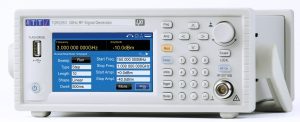The TGR2051/2053 RF signal sources provide exceptional performance with touch-screen operation for improved functionality to support research and development, test and service applications

Saelig Company, Inc. announces the availability of the AIM-TTi TGR2051 and TGR2053 RF Signal Generators, a major revision of their successful TGR 2000 series, which both offer exceptional performance, very low phase noise, and flexible functionality, offering output signals from 150kHz to 1.5 and 3GHz respectively. These versatile RF generators provide excellent frequency accuracy and stability, large signal amplitude range, low phase noise and extensive analog and digital modulation capabilities. Output power levels from -127dBm to +13dBm are available with 50VDC reverse voltage protection.
Both models feature a simple, user friendly, touch-operated GUI, with the 4.3” color LCD clearly showing all relevant information and settings. Parameters can be adjusted from the menu on the LCD touch-screen or by using the front-panel keys and rotary wheel. A front-mounted USB flash drive allows pre-defined complex setups, sweep lists, and modulation patterns to be loaded into the instrument quickly and efficiently. 4GB of non-volatile internal memory is provided for storing multiple setups, sweep lists, arbitrary modulation patterns and more. Up to 1000 complete setups can be stored internally.
The instrument’s built-in DDS generator provides sine, square, +ramp, -ramp and triangle waves, and these can be applied in AM, FM or PM from the internal modulation source at frequencies ranging from 1mHz to 1MHz. External analog modulation signals can be applied via the rear panel. An extensive number of digital modulations are also available: FSK, GFSK, MSK, GMSK, HMSK, 3FSK, 4FSK, PSK, ASK and OOK. Built in NRZ patterns include square wave, 7, 9, 11 & 15-bit PRBS. Digital modulation capabilities also include advanced filtering: Gaussian, Raised Cosine, Root Raised Cosine and Half Sine, as well as Grey Code and Binary Encoding. External digital modulation signals can be applied to the carrier waveform via the rear panel. A user-defined pattern generator is also included for modulating the carrier signal. Digital modulation and modulation patterns can be continuous or triggered externally, internally, manually, or remotely.
The sweep function can vary frequency and/or amplitude to test a wide range of input conditions. Linear or logarithmic sweeps can operate upwards or downwards. Alternatively, List Mode can be used to analyze a response at set frequencies and amplitude, dwelling on set values for specified periods. This technique is useful for tests at specific suspected problematic frequencies. Complex sweep triggering can control complete sweeps and/or each point within a sweep.
Read more: NEXT GENERATION AIM-TTI 1.5/3GHZ RF SIGNAL GENERATORS
